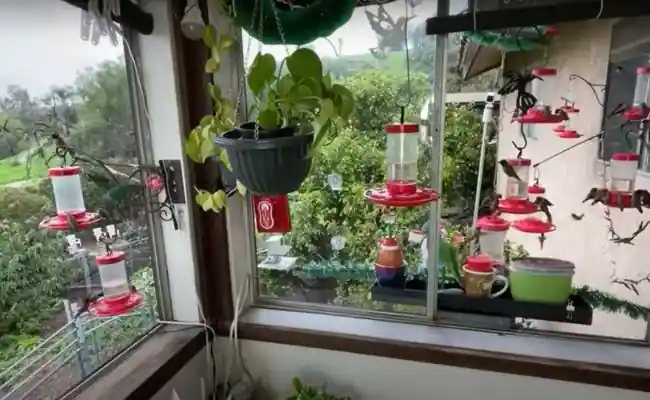To replace hummingbird nectar is a challenging job. My friends often question me about how frequently the nectar should be replaced in the hummer feeder.
To host hummingbirds in your backyard and watch them flit from flower to flower is eye-catching. Although, this spectacle transcends you into a world of the marvelous beauty of those tiny helicopters their survival is essential and depends on nectar and protein.
You need a good feeding spot for them and changing the nectar often is super important to ensure the health of beautiful creatures.
After placing nectar feeders in your garden, you should take excellent care of them to save them from mold entering that can kill the little birds. If somehow the nectar doesn’t remain fresh and mold starts developing, you swap the food with fresh nectar.
How often the nectar is to change is a question about which many bird lovers wonder about. With different opinions out there, it can be confusing. No worries, I am here to clear things up for you!
How Often to Change Hummingbird Nectar and Clean Your Feeder?
Hummingbird nectar can be spoiled faster than you might think. Even if the nectar in your feeder looks fine, it might have gone bad. That’s why, I made it a habit to change it regularly. Actually determining how often to replace hummingbird nectar depends on different factors like weather conditions and nectar ingredients.
In simple words, you just observe how the nectar looks when you just mix the ingredients, it has a crystal clear look but after 2 to 3 days in hot weather, you’ll see that it’s now a bit cloudy. Now it’s the time to change the nectar.
In the scorching sun, I’ve witnessed nectar spoil in half a day. If the temperature is above 90 degrees, refill the feeder with fresh nectar. The most desirable thing is that you should change nectar every day once you get into the mid 80’s.
See, When the feeder is not exposed to direct sunlight and the weather is cooler like 60 degrees, you can change the nectar after 2-3 days, because it’s kind of like a refrigerator outside so it makes it easier to keep the feeders.
Nectar Freshness is Everything
Through years of observing my hummingbirds, I’ve learned that nectar freshness is non-negotiable. The unchanged nectar can contain mold and other harmful bacteria. so if you want to see these little birds in your yard, do not compromise on their food. In your yard, nectar freshness is everything.
The hummingbirds won’t taste the spoiled or fermented nectar, it can make them sick. I know the importance of fresh food for these cuties, yet in my early hummingbird hosting days, I made that rookie mistake of letting nectar stay too long. Believe me, that was my worst experience and I felt so bad at that time when 1 hummingbird lost his life just because of my mistake.
The Factors Affecting Nectar Freshness?
There are multiple factors that affect the nectar freshness, such as weather conditions, direct sunlight exposure, and humidity. The temperature plays a big role. Humidity plays a significant role in the quality and longevity of nectar in hummingbird feeders.
In hotter and more humid climates, nectar has a higher tendency to ferment quickly. This means that it can spoil faster due to the warm and moist conditions and it will be less attracted by hummingbirds. When nectar ferments, it becomes less nutritious and potentially harmful to hummingbirds.
Mold and bacteria multiply rapidly in hot weather. According to Georgia Wildlife, in a study, scientists found that when hummingbirds drank nectar heated to 102.2 F the metabolic rate of hummingbirds increased and it could harm their metabolic system. Hot nectar might also burn their tongues.
In hot temperatures, nectar spoils quickly and can be a problem. It’s like cooking the nectar before the hummingbirds even get a chance to taste it. when I placed my feeder in full sun on a hot day, within hours, the nectar turned cloudy and smelled off.
The placement of feeders is also crucial to provide fresh nectar to the hummers. To attract dozens of hummingbirds you must read my guide about where to place hummingbird feeders.
How to know Hummingbird Nectar is Bad?
Making sure the availability of fresh nectar is really important for keeping the little birds healthy. Here are some things that might show if the nectar has gone bad:
- Hummingbirds will avoid visiting feeders with spoiled nectar.
- Nectar is apparently cloudy.
- Dead insects or sticky residue in feeding pots.
- Mold growth inside and outside the feeder.
- Stringy or speckled appearance in nectar.
- An unpleasant or sour odor is a sign of bad nectar.
Cleaning is the Key
No matter the temperature reading, one crucial step never changes and that is regularly and thoroughly cleaning the feeders. A simple hot water and vinegar scrub whisks away residues and microorganisms that accelerate spoilage. This sanitizing process, combined with frequent nectar refilling, has transformed my yard into a hummingbird haven.
Keeping your hummingbird feeder clean is super important to make sure the nectar stays fresh and safe for those little birds. How do you do it?
- Clean your feeder with warm, soapy water at least every few days, especially in hot weather. This helps remove any leftover nectar and prevents mold or bacteria from growing.
- Get a special brush designed for cleaning hummingbird feeders. It can reach all the nooks and crannies, making sure you get rid of any stuck-on gunk.
- Pay extra attention to cleaning the feeding ports where the hummingbirds drink from.
- Don’t forget to clean the inside of the feeder, too.
How to Make Your Own Hummingbird Nectar?
I always prefer homemade nectar over store-bought nectar for my lovely birds. I know that store-bought nectar may contain preservatives and food coloring that can be harmful to hummingbirds. Here is the simple recipe for you to make nectar at home:
- Sugar and water are the only ingredients of nectar.
- Combine 1 part refined white sugar with 4 parts warm water in a pot.
- Heat the water to dissolve the sugar.
- Let the mixture cool before filling the feeder.
- Fill the nectar in the feeder.
Here are some important things that you must keep in mind:
- Use only refined white sugar, avoiding honey, brown sugar, powdered sugar, or other sweeteners.
- Do not add red food coloring as it is unnecessary and could be harmful to hummingbirds.
- Change and clean feeders every other day to prevent mold growth.
Conclusion
Maintaining the perfect fresh nectar schedule requires carefully considering the seasons and temperatures. In summer time’s heat, even a mere 12-hour stretch between changes is too long. With the seasons changing, you need to change how often you refill the hummingbird nectar.
Don’t forget, it’s not only about bringing these amazing birds to your garden. It’s also about keeping them safe and healthy. If you watch out and do easy things like making fresh nectar and keeping the feeders clean, you can make your yard a safe and happy place for hummingbirds to visit.



